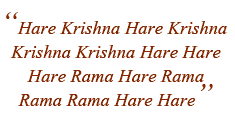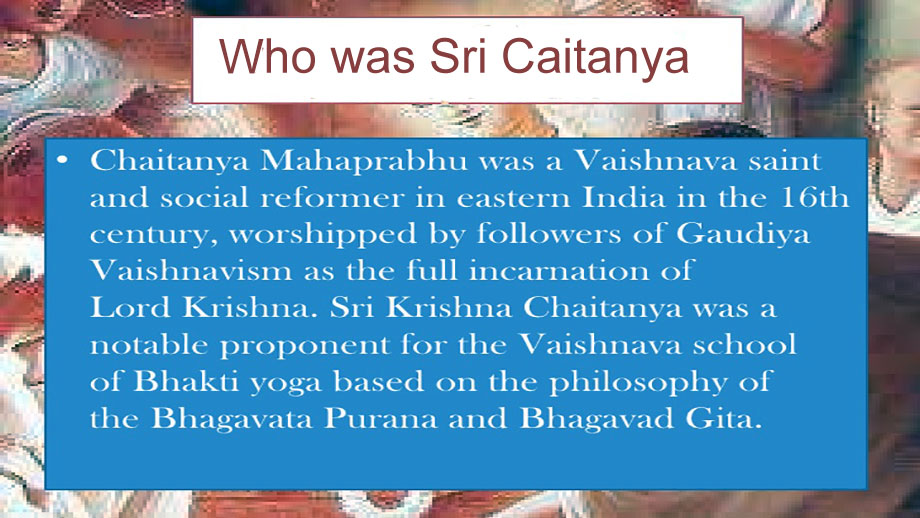Lord Chaitanya
Sri Chaitanya Mahaprabhu, who is an incarnation of the Supreme Personality of Godhead Krishna, introduced a revolutionary spiritual movement based on India’s ancient Vedic literature. He swept aside the stifling restrictions of the degenerated caste system and allowed people everywhere to transcend social barriers and achieve the highest platform of spiritual enlightenment through the chanting of the Hare Krishna mantra.
India’s Vedic scriptures had long predicted His birth in 1486 in Mayapur, India. As He grew to young manhood, Lord Chaitanya began to carry out His divine mission of distributing love of God to people in every station of life. Sri Chaitanya taught that this awakening could be attained by the chanting of God’s holy names, the Hare Krishna mantra: Hare Krishna, Hare Krishna, Krishna Krishna, Hare Hare / Hare Rama, Hare Rama, Rama Rama, Hare Hare.
As He travelled throu ghout India, hundreds of thousands of people would join Him in massive chanting parties. Sri Chaitanya often recited to them a Sanskrit verse that described the essence of His teachings:
ghout India, hundreds of thousands of people would join Him in massive chanting parties. Sri Chaitanya often recited to them a Sanskrit verse that described the essence of His teachings:
harer nama harer nama harer namaiva kevalam
kalau nasty eva nasty eva nasty eva gatir anyatha
“In this age of Kali (quarrel and anxiety) there is no alternative for spiritual progress other than chanting of the holy names of God.”Hare Krishna Mantra
After the sankirtana movement had gained popularity, a small group of envious Hindus from His hometown decided to harass the Lord and His devotees. They decided to lie to the local Muslim magistrate (Kazi), saying that the Lord was violating Hindu doctrine. Subsequently the Kazi, named Maulana Sirajuddin, sent constables who stopped the devotees’ chanting. In response, Chaitanya Mahaprabhu organized a 100,000 – strong civil disobedience party that chanted and danced on the streets of Navadvipa in violation of the magistrate’s order.
After reaching the Kazi’s home, the Lord explained that the chanting of the Hare Krishna mantra was a bonafide Vedic method for worshiping God, especially in this age. The Kazi, moved by the Lord’s purity, declared it an offense for anyone to interfere with the sankirtana movement from that time onward. Today, pilgrims still visit the tomb of the Kazi in Navadvipa to pay their respects.
The teachings of Sri Chaitanya form the philosophical basis of the International Society for Krishna Consciousness (ISKCON). In 1986, ISKCON members and millions of people throughout India and the world celebrated the 500th anniversary of the advent of Sri Chaitanya.
Chaitanya Mahaprabhu advocated a universal religion for all humanity, a scientific process of spiritual awakening that was taken across the globe by the relentless efforts of His Divine Grace A. C . Bhaktivedanta Swami Prabhupada.
Lord Chaitanya’s Mission
Lord Chaitanya Mahaprabhu instructed His disciples to write books on the Science of Krishna, a task which those who follow Him have continued to carry out down to the present day. The elaborations and expositions on the philosophy taught by Lord Chaitanya are in fact most voluminous, exacting and consistent due to the system of disciplic succession. Although Lord Chaitanya was widely renowned as a scholar in His youth, He left only eight verses, called Sikshastaka. These eight verses clearly reveal His mission and precepts.
Appearance of Caitanya Mahaprabhu
Chaitanya Mahaprabhu was born in Mayapur in the town of Nadia just after sunset on th e evening of the 23rd Phalguna 1407 Sakabda, answering to the 18th of February, 1486, of the Christian era. The moon was eclipsed at the time of His birth, and the people of Nadia were then engaged, as was usual on such occasions, in bathing in the Ganga with loud cheers of “Haribol!” His father, Jagannatha Mishra, a brahmana of the Vedic order, and His mother, Sachidevi, a model good woman, both descended from brahmana families originally residing in Sylhet.
e evening of the 23rd Phalguna 1407 Sakabda, answering to the 18th of February, 1486, of the Christian era. The moon was eclipsed at the time of His birth, and the people of Nadia were then engaged, as was usual on such occasions, in bathing in the Ganga with loud cheers of “Haribol!” His father, Jagannatha Mishra, a brahmana of the Vedic order, and His mother, Sachidevi, a model good woman, both descended from brahmana families originally residing in Sylhet.
Mahaprabhu was a beautiful child, and the ladies of the town came to see Him with presents. His mother’s father, Pandit Nilambara Chakravarti, a renowned astrologer, foretold that the child would be a great personage in time; and he, therefore, gave Him the name Vishvambhara. The ladies of the neighborhood called Him Gaurahari on account of His golden complexion, and His mother called Him Nimai on account of the nimba tree near which He was born. Beautiful as He was, everyone loved to see Him every day.

















